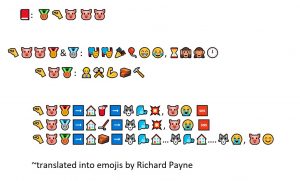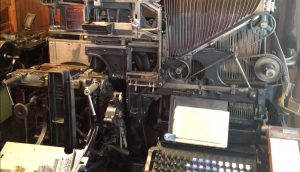1977 must have been a time of great hope and wonder to send into the cosmos artifacts of our human culture in hope that it one day may be discovered. Somehow, I feel that people today may recognize that mathematically it is nearly impossible that extraterrestrial life doesn’t exist, and yet we might be too cynical to undertake such an endeavor today. NASA was an organization at the time with the audacity or pure curiosity to undertake such a task. One of those artifacts ‘on board’ was to no surprise music. How would you go about selecting 27, or even just 10 of the worlds ‘greatest hits’? What best represents humanity? Is the sophistication of a piece, the emotions that it stimulates? NASA scientists knew that whatever beings might find this in some distant place in the future may not even have the ability to hear, and so, they also considered things like the mathematical resonance of a piece. Perhaps with today’s technology we would not have to limit it to a 27-track piece, and we could overwhelm the aliens with choice much as we are today. Indeed, we take the anthropocentric view that the aliens would be most intrigued with our human musical expressions, but it is exactly this assumption that is challenged in Gene Roddenberry’s science fiction work Star Trek IV, The Voyage Home. In it, a sophisticated alien intelligence visits earth that humans cannot communication with. People realize that the aliens are trying to communicate with the whales, which from discovering voyager they determined to be the most sophisticated life on earth. Note that the real Voyager did include various sounds of nature and animals. In that fictional future whales had already been extinct for some time, no doubt at the hands of man, much to the alien’s chagrin. The starship Enterprise must then travel back in time to save the whales, in order to save humanity. This is a fanciful story, but one that intrigued the imagination of many at the time to place importance on the welfare of such majestic beings on the earth. This important narrative of valuing planetary life interestingly was contributed in part to, us putting hope in the cosmos.
Back to the music section of the archives sent into deep space on that hopeful mission, the question posed in this task is, could you narrow 27 pieces down to 10 and can you explain why you would make those choices? Full disclosure I am no musician although, like most humans, I do have a great appreciation for ‘good’ music. But what is good? In all honesty, none of the 27 would have even made my list, and I dare say that list today would be much different. I mean, Johnny Be Good? I guess you had to be there to appreciate it fully? The era of classical music for example is so incredibly powerful, there are pieces that stir me so deeply it is undeniable. I was saddened to see none of my favorites made NASA’s list. Going through the list in a painful exercise to narrow down and cut out so many beautiful pieces made me realize how subjective the process was for me. Even for the great scientific minds at NASA when it comes to selecting musical beauty, surely much must be in the ear of the beholder. But I digress, I will do my best however to narrow down 27 to the 10 of those that I think would best represent our species!
See if you agree ~ or not!
For my reader’s reference, I will give you the full list, and then I will highlight in green the 10 I chose with a brief note as to why. For your convenience each piece is linked to the YouTube track. Enjoy!
Music From Earth
The following music was included on the Voyager record.
1.
- Bach, Brandenburg Concerto No. 2 in F. First Movement, Munich Bach Orchestra, Karl Richter, conductor. 4:40
- Yes, Bach does belong on my list of the greatest musical geniuses of all time. This piece selected is not my favourites, the two pieces of his I appreciate most that sends my mind into another world would be Orchestral Suites No. 3 in D major, BWV 1068 and Cello Suite No. 1 in G Major BWV1007 – Mov. 1-3/6 Due to Bach’s sheer mastery of such a range of instruments and harmony, I would leave in my top 10 this piece by Bach even though I don’t believe it is his best piece. As a side note, genius he may be and a spot on the list he should have, however, when selecting 27 pieces to represent humanity, I think it is clearly not representative to have Bach featured three times. Therefore, I have not selected the other two in my top 10.
2.
- Java, court gamelan, “Kinds of Flowers,” recorded by Robert Brown. 4:43
- Yes. Maybe. I can’t decide if I love this or not. There is something deep and almost religious about it. Having said that, I am not sure how it makes me feel or whether I would ever listen to it of my own volition. It reminds me of the cultural diversity on earth and how I cannot relate it to anything in my own life. It is so interesting however, that yes, I would include it.
- Senegal, percussion, recorded by Charles Duvelle. 2:08
- Zaire, Pygmy girls’ initiation song, recorded by Colin Turnbull. 0:56
3.
- Australia, Aborigine songs, “Morning Star” and “Devil Bird,” recorded by Sandra LeBrun Holmes. 1:26
- Yes. The Australian Aboriginals are one of the oldest living cultures on earth. They also have a very interesting relationship with the dream world. The digeridoo is also one of the hardest instruments on earth to play, requiring circular breathing which I find incredible. I wish there was more of it on this track.
4.
- Mexico, “El Cascabel,” performed by Lorenzo Barcelata and the Mariachi México. 3:14
- Yes. The complexity that roles out in this piece along with its exciting tone and pace give it a certain pizzazz that perhaps no other track on this list does. The plethora of instruments along with the beautiful signing displays how we can integrate ourselves with the instruments of our creation.
- “Johnny B. Goode,” written and performed by Chuck Berry. 2:38
- New Guinea, men’s house song, recorded by Robert MacLennan. 1:20
5.
- Japan, shakuhachi, “Tsuru No Sugomori” (“Crane’s Nest,”) performed by Goro Yamaguchi. 4:51
- Yes. Admittedly my biased does come into play here. Having lived in Japan, hearing the shakuhachi sends me to a meditative Zen feeling. I think the beauty of this piece, like so much of man’s art, it is an ode to nature. It is an imitation of the beauty we see in the natural world, which is, in a sense what we would want to convey to an alien species about our love for our planet.
- Bach, “Gavotte en rondeaux” from the Partita No. 3 in E major for Violin, performed by Arthur Grumiaux. 2:55
6.
- Mozart, The Magic Flute, Queen of the Night aria, no. 14. Edda Moser, soprano. Bavarian State Opera, Munich, Wolfgang Sawallisch, conductor. 2:55
- Yes. This masterpiece is also a wonderful representation of the vocal capabilities of the human voice.
7.
- Georgian S.S.R., chorus, “Tchakrulo,” collected by Radio Moscow. 2:18
- Yes. The Georgian choir is almost a religious experience to listen to. The experience as above with the Zaire Pygmy Girl, is an outstanding example of people singing in unison. To me the Pygmy Girl didn’t quite make my cut. It is a shame because I feel there are so many incredible and moving pieces out of Africa, I just didn’t find them on this list of 27.
- Peru, panpipes and drum, collected by Casa de la Cultura, Lima. 0:52
- “Melancholy Blues,” performed by Louis Armstrong and his Hot Seven. 3:05
- Azerbaijan S.S.R., bagpipes, recorded by Radio Moscow. 2:30
- Stravinsky, Rite of Spring, Sacrificial Dance, Columbia Symphony Orchestra, Igor Stravinsky, conductor. 4:35
- Bach, The Well-Tempered Clavier, Book 2, Prelude and Fugue in C, No.1. Glenn Gould, piano. 4:48
8.
- Beethoven, Fifth Symphony, First Movement, the Philharmonia Orchestra, Otto Klemperer, conductor. 7:20
- Yes. To me, this is not solely a happy piece, rather it speaks to the peaks and valleys of the human experience. Again, it may not have made my personal list, but is it a masterpiece? Absolutely.
- Bulgaria, “Izlel je Delyo Hagdutin,” sung by Valya Balkanska. 4:59
- Navajo Indians, Night Chant, recorded by Willard Rhodes. 0:57
- Holborne, Paueans, Galliards, Almains and Other Short Aeirs, “The Fairie Round,” performed by David Munrow and the Early Music Consort of London. 1:17
- Solomon Islands, panpipes, collected by the Solomon Islands Broadcasting Service. 1:12
- Peru, wedding song, recorded by John Cohen. 0:38
9.
- China, ch’in, “Flowing Streams,” performed by Kuan P’ing-hu. 7:37
- Yes. I believe the instrument used is a The guqin. Someone please correct me if I am wrong. It is one of the Chinese stringed instruments. The sound is so incredible it absolutely tells a story. The NASA scientist saw fit for it to take up over seven minutes of track and presumably they were constrained by space. There are many fantastic guqin pieces to choose from, but I do agree this is a powerful piece and absolutely belongs in the 27 and certainly in my 10.
10.
- India, raga, “Jaat Kahan Ho,” sung by Surshri Kesar Bai Kerkar. 3:30
- Yes. Without even understanding the lyrics, this is a stirring piece. Indian music was coming into mainstream appreciation in the late 60s and early 1970s influencing bands such as the Beatles and Led Zeppelin, so it is not entirely surprising to hear this genre of traditional music. Reading what people have commented about the lyrics of this of this song, it is about a girl coming of age and going out into the world. How fitting for Voyager, itself is a creation of man that has come to a point in technology when it can be sent out into the unknown with great expectations and apprehension.
- “Dark Was the Night,” written and performed by Blind Willie Johnson. 3:15
- Beethoven, String Quartet No. 13 in B flat, Opus 130, Cavatina, performed by Budapest String Quartet. 6:37




